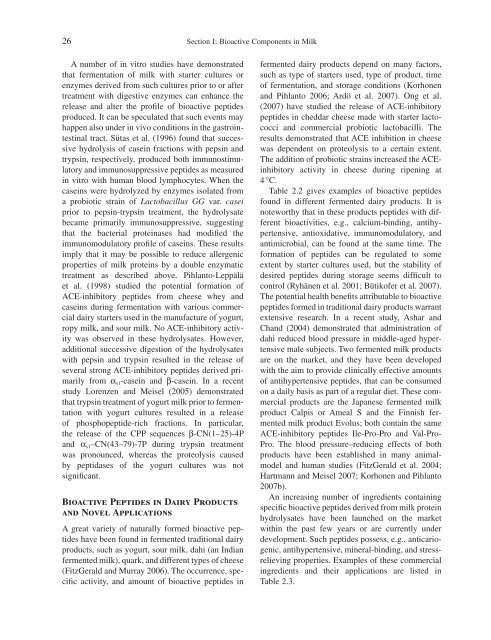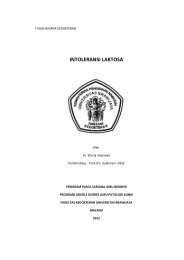Bioactive Components in Milk and Dairy Products - Prof. Dr. Aulanni ...
Bioactive Components in Milk and Dairy Products - Prof. Dr. Aulanni ...
Bioactive Components in Milk and Dairy Products - Prof. Dr. Aulanni ...
Create successful ePaper yourself
Turn your PDF publications into a flip-book with our unique Google optimized e-Paper software.
26 Section I: <strong>Bioactive</strong> <strong>Components</strong> <strong>in</strong> <strong>Milk</strong><br />
A number of <strong>in</strong> vitro studies have demonstrated<br />
that fermentation of milk with starter cultures or<br />
enzymes derived from such cultures prior to or after<br />
treatment with digestive enzymes can enhance the<br />
release <strong>and</strong> alter the profi le of bioactive peptides<br />
produced. It can be speculated that such events may<br />
happen also under <strong>in</strong> vivo conditions <strong>in</strong> the gastro<strong>in</strong>test<strong>in</strong>al<br />
tract. S ü tas et al. (1996) found that successive<br />
hydrolysis of case<strong>in</strong> fractions with peps<strong>in</strong> <strong>and</strong><br />
tryps<strong>in</strong>, respectively, produced both immunostimulatory<br />
<strong>and</strong> immunosuppressive peptides as measured<br />
<strong>in</strong> vitro with human blood lymphocytes. When the<br />
case<strong>in</strong>s were hydrolyzed by enzymes isolated from<br />
a probiotic stra<strong>in</strong> of Lactobacillus GG var. casei<br />
prior to peps<strong>in</strong> - tryps<strong>in</strong> treatment, the hydrolysate<br />
became primarily immunosuppressive, suggest<strong>in</strong>g<br />
that the bacterial prote<strong>in</strong>ases had modifi ed the<br />
immunomodulatory profi le of case<strong>in</strong>s. These results<br />
imply that it may be possible to reduce allergenic<br />
properties of milk prote<strong>in</strong>s by a double enzymatic<br />
treatment as described above. Pihlanto - Lepp ä l ä<br />
et al. (1998) studied the potential formation of<br />
ACE - <strong>in</strong>hibitory peptides from cheese whey <strong>and</strong><br />
case<strong>in</strong>s dur<strong>in</strong>g fermentation with various commercial<br />
dairy starters used <strong>in</strong> the manufacture of yogurt,<br />
ropy milk, <strong>and</strong> sour milk. No ACE - <strong>in</strong>hibitory activity<br />
was observed <strong>in</strong> these hydrolysates. However,<br />
additional successive digestion of the hydrolysates<br />
with peps<strong>in</strong> <strong>and</strong> tryps<strong>in</strong> resulted <strong>in</strong> the release of<br />
several strong ACE - <strong>in</strong>hibitory peptides derived primarily<br />
from α s1 - case<strong>in</strong> <strong>and</strong> β - case<strong>in</strong>. In a recent<br />
study Lorenzen <strong>and</strong> Meisel (2005) demonstrated<br />
that tryps<strong>in</strong> treatment of yogurt milk prior to fermentation<br />
with yogurt cultures resulted <strong>in</strong> a release<br />
of phosphopeptide - rich fractions. In particular,<br />
the release of the CPP sequences β - CN(1 – 25) - 4P<br />
<strong>and</strong> α s1 – CN(43 – 79) - 7P dur<strong>in</strong>g tryps<strong>in</strong> treatment<br />
was pronounced, whereas the proteolysis caused<br />
by peptidases of the yogurt cultures was not<br />
signifi cant.<br />
<strong>Bioactive</strong> Peptides <strong>in</strong> <strong>Dairy</strong> <strong>Products</strong><br />
<strong>and</strong> Novel Applications<br />
A great variety of naturally formed bioactive peptides<br />
have been found <strong>in</strong> fermented traditional dairy<br />
products, such as yogurt, sour milk, dahi (an Indian<br />
fermented milk), quark, <strong>and</strong> different types of cheese<br />
(FitzGerald <strong>and</strong> Murray 2006 ). The occurrence, specifi<br />
c activity, <strong>and</strong> amount of bioactive peptides <strong>in</strong><br />
fermented dairy products depend on many factors,<br />
such as type of starters used, type of product, time<br />
of fermentation, <strong>and</strong> storage conditions (Korhonen<br />
<strong>and</strong> Pihlanto 2006 ; Ard ö et al. 2007 ). Ong et al.<br />
(2007) have studied the release of ACE - <strong>in</strong>hibitory<br />
peptides <strong>in</strong> cheddar cheese made with starter lactococci<br />
<strong>and</strong> commercial probiotic lactobacilli. The<br />
results demonstrated that ACE <strong>in</strong>hibition <strong>in</strong> cheese<br />
was dependent on proteolysis to a certa<strong>in</strong> extent.<br />
The addition of probiotic stra<strong>in</strong>s <strong>in</strong>creased the ACE -<br />
<strong>in</strong>hibitory activity <strong>in</strong> cheese dur<strong>in</strong>g ripen<strong>in</strong>g at<br />
4 ° C.<br />
Table 2.2 gives examples of bioactive peptides<br />
found <strong>in</strong> different fermented dairy products. It is<br />
noteworthy that <strong>in</strong> these products peptides with different<br />
bioactivities, e.g., calcium - b<strong>in</strong>d<strong>in</strong>g, antihypertensive,<br />
antioxidative, immunomodulatory, <strong>and</strong><br />
antimicrobial, can be found at the same time. The<br />
formation of peptides can be regulated to some<br />
extent by starter cultures used, but the stability of<br />
desired peptides dur<strong>in</strong>g storage seems diffi cult to<br />
control (Ryh ä nen et al. 2001 ; B ü tikofer et al. 2007 ).<br />
The potential health benefi ts attributable to bioactive<br />
peptides formed <strong>in</strong> traditional dairy products warrant<br />
extensive research. In a recent study, Ashar <strong>and</strong><br />
Ch<strong>and</strong> (2004) demonstrated that adm<strong>in</strong>istration of<br />
dahi reduced blood pressure <strong>in</strong> middle - aged hypertensive<br />
male subjects. Two fermented milk products<br />
are on the market, <strong>and</strong> they have been developed<br />
with the aim to provide cl<strong>in</strong>ically effective amounts<br />
of antihypertensive peptides, that can be consumed<br />
on a daily basis as part of a regular diet. These commercial<br />
products are the Japanese fermented milk<br />
product Calpis or Ameal S <strong>and</strong> the F<strong>in</strong>nish fermented<br />
milk product Evolus; both conta<strong>in</strong> the same<br />
ACE - <strong>in</strong>hibitory peptides Ile - Pro - Pro <strong>and</strong> Val - Pro -<br />
Pro. The blood pressure – reduc<strong>in</strong>g effects of both<br />
products have been established <strong>in</strong> many animal -<br />
model <strong>and</strong> human studies (FitzGerald et al. 2004 ;<br />
Hartmann <strong>and</strong> Meisel 2007 ; Korhonen <strong>and</strong> Pihlanto<br />
2007b ).<br />
An <strong>in</strong>creas<strong>in</strong>g number of <strong>in</strong>gredients conta<strong>in</strong><strong>in</strong>g<br />
specifi c bioactive peptides derived from milk prote<strong>in</strong><br />
hydrolysates have been launched on the market<br />
with<strong>in</strong> the past few years or are currently under<br />
development. Such peptides possess, e.g., anticariogenic,<br />
antihypertensive, m<strong>in</strong>eral - b<strong>in</strong>d<strong>in</strong>g, <strong>and</strong> stress -<br />
reliev<strong>in</strong>g properties. Examples of these commercial<br />
<strong>in</strong>gredients <strong>and</strong> their applications are listed <strong>in</strong><br />
Table 2.3 .





